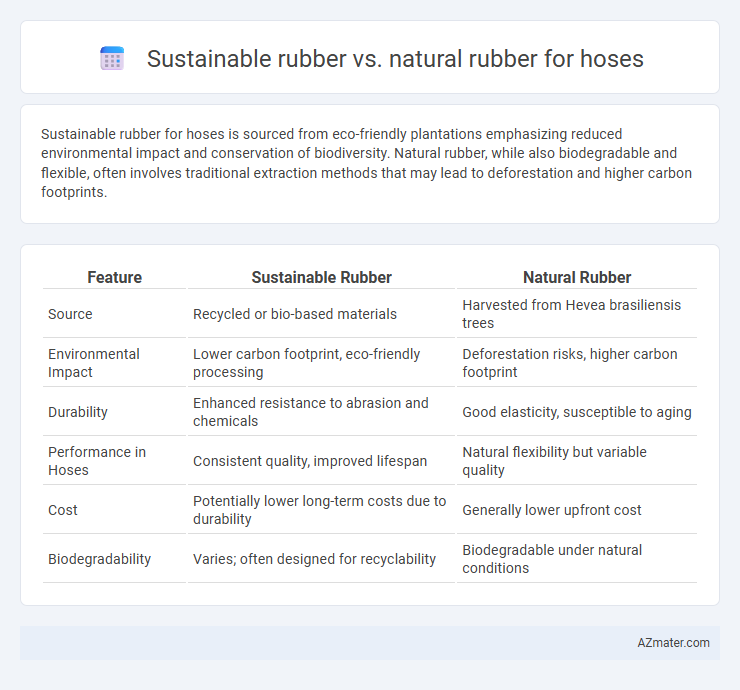Sustainable rubber for hoses is sourced from eco-friendly plantations emphasizing reduced environmental impact and conservation of biodiversity. Natural rubber, while also biodegradable and flexible, often involves traditional extraction methods that may lead to deforestation and higher carbon footprints.
Table of Comparison
| Feature | Sustainable Rubber | Natural Rubber |
|---|---|---|
| Source | Recycled or bio-based materials | Harvested from Hevea brasiliensis trees |
| Environmental Impact | Lower carbon footprint, eco-friendly processing | Deforestation risks, higher carbon footprint |
| Durability | Enhanced resistance to abrasion and chemicals | Good elasticity, susceptible to aging |
| Performance in Hoses | Consistent quality, improved lifespan | Natural flexibility but variable quality |
| Cost | Potentially lower long-term costs due to durability | Generally lower upfront cost |
| Biodegradability | Varies; often designed for recyclability | Biodegradable under natural conditions |
Introduction to Rubber Materials for Hoses
Sustainable rubber for hoses incorporates eco-friendly materials derived from renewable sources or recycled content, reducing environmental impact compared to traditional natural rubber, which is harvested directly from rubber trees (Hevea brasiliensis). Natural rubber provides excellent elasticity and tensile strength, making it a preferred material for flexible hose applications, but its production raises concerns about deforestation and biodiversity loss. Innovations in sustainable rubber, such as bio-based synthetic alternatives and reclaimed rubber blends, aim to maintain performance standards while promoting resource efficiency and reducing carbon footprint in hose manufacturing.
Defining Sustainable Rubber: Key Characteristics
Sustainable rubber for hoses is derived from sources that prioritize environmental preservation, such as responsibly managed rubber plantations and agroforestry systems that reduce deforestation and promote biodiversity. Key characteristics include reduced carbon footprint, minimal chemical use, and enhanced soil health, distinguishing it from conventional natural rubber often associated with high environmental impact. This sustainable approach ensures consistent quality and durability for hoses while supporting ethical supply chains and long-term ecological balance.
What is Natural Rubber? Sourcing and Properties
Natural rubber, derived from the latex of Hevea brasiliensis trees, is prized for its high elasticity, tensile strength, and resistance to wear, making it a preferred choice for hose manufacturing. Sourced primarily from Southeast Asia, this renewable material offers excellent flexibility and durability in dynamic pressure and temperature conditions. Sustainable rubber incorporates eco-friendly harvesting and processing methods that reduce environmental impact while maintaining the essential physical properties required for hose applications.
Environmental Impact: Sustainable vs Natural Rubber
Sustainable rubber production significantly reduces environmental impact by minimizing deforestation, conserving biodiversity, and lowering carbon emissions compared to traditional natural rubber harvesting. It employs eco-friendly practices such as agroforestry, integrated pest management, and responsible land use that promote soil health and water conservation. This contrasts with conventional natural rubber cultivation, which often involves monoculture plantations linked to habitat loss and higher ecological footprints.
Performance Comparison: Durability and Flexibility
Sustainable rubber for hoses demonstrates enhanced durability due to eco-friendly processing methods that minimize degradation of polymer chains, resulting in longer service life compared to traditional natural rubber. The flexibility of sustainable rubber often matches or exceeds that of natural rubber, as advanced compounding techniques allow for improved elasticity without compromising strength. Performance metrics such as tensile strength, abrasion resistance, and fatigue life consistently show sustainable rubber as a competitive or superior alternative in hose applications.
Cost Analysis: Sustainable Rubber vs Natural Rubber
Sustainable rubber typically incurs higher upfront costs compared to natural rubber due to eco-friendly cultivation and processing methods, but it offers long-term savings through reduced environmental compliance fees and enhanced durability in hose applications. Natural rubber benefits from established supply chains and lower initial prices, yet fluctuates with market volatility and environmental regulations that can increase overall expenses. Evaluating total lifecycle costs reveals sustainable rubber as a cost-efficient choice for hoses prioritizing environmental impact and performance stability.
Manufacturing Processes and Resource Use
Sustainable rubber for hoses incorporates eco-friendly manufacturing processes such as reduced energy consumption and minimal chemical use, promoting resource efficiency compared to traditional natural rubber production. The sustainable approach often utilizes recycled or renewable materials, decreasing reliance on deforestation and lowering carbon footprints throughout the supply chain. Natural rubber manufacturing typically involves intensive cultivation and harvesting methods that demand significant water and land resources, contributing to environmental degradation.
Regulatory and Certification Standards
Sustainable rubber for hoses adheres to stringent regulatory frameworks such as the FSC (Forest Stewardship Council) and Rainforest Alliance certifications, ensuring eco-friendly sourcing and reduced environmental impact. Natural rubber, while traditionally compliant with ISO 9001 and REACH regulations, often lacks the comprehensive sustainability credentials that drive market preference toward green alternatives. Compliance with these certification standards is critical for meeting global environmental policies and enhancing product traceability in industrial hose applications.
Industry Adoption and Market Trends
Sustainable rubber is increasingly favored in the hose manufacturing sector due to rising environmental regulations and demand for eco-friendly materials, driving significant industry adoption. Market trends indicate a shift towards sustainable rubber variants such as bio-based and reclaimed rubber, offering reduced carbon footprints without compromising durability or performance. Major hose manufacturers are investing in research and partnerships to integrate sustainable rubber, reflecting a broader commitment to circular economy principles and regulatory compliance.
Conclusion: Choosing the Right Rubber for Hoses
Selecting the right rubber for hoses depends on balancing environmental impact, durability, and performance. Sustainable rubber offers eco-friendly advantages with reduced carbon footprint and improved traceability, making it ideal for environmentally-conscious applications. Natural rubber remains preferred for its exceptional elasticity and abrasion resistance, ensuring high performance in demanding hose applications.

Infographic: Sustainable rubber vs Natural rubber for Hose
 azmater.com
azmater.com